Shoto Shihan Kai International (JKA)
shotokanfitnesskarate@gmail.com | +91.9874091619
Shotokan Fitness Karate Organisation. SFKO
Japan Karate Association. JKA
United Nation Institute for Training And Research. UNITAR
International Registered Number: G-232228
World Shotokan Karate Sports Council
About the Japan Karate Association
Founded in 1948, the Japan Karate Association (JKA) was highly appreciated for its social activities, and received approval from the Japanese Ministry of Education as a “General Incorporated Association” in 1957. From then until now, we have devoted our effort to inherit and develop this irreplaceable martial arts culture born in Japan. Consequently, on 21st March, 2012, we were approved as ” Public Interest Incorporated Association” by the Prime Minister.
The Japan Karate Association aims to promote improvement of its skills and self-discipline by research and instruction of Karatedo, thereby contributing to the improvement of the well-being of the people and cultivate a sound martial arts spirit. Moreover, it aims to contribute to world peace by spreading the spirit of Japanese martial arts which respects courtesy to countries all over the world.
In order to achieve these objectives, we the JKA engage in the following activities.
Instruction
The JKA has consistently instructed and promoted Karatedo since its establishment in 1948. From the beginning we have trained specialized instructors who have completed our own curriculums, and established a solid foundation on instruction and technique of Karatedo.
The educational philosophy of Martial Arts trying to develop their own personality through daily hard training is getting high appraisal and trust. This Martial Art has already gained high achievements in youth education being adopted as a regular school subject.
The Japan Karate Association has the best technique system and instruction system. There are around 30 specialized instructors who are in charge of instructing Japanese as well as foreign practitioners from all over the world. Furthermore, JKA HQ dispatches them all over the world in response to requests.
Prime Minister Cup JKA All Japan Karate Championship
The Japan Karate Association holds a national Championship Tournament every year as a part of activities. It was October 1957 when the 1st National Karate Championship was held at the Tokyo gymnasium. It was the first time to demonstrate Karatedo as a tournament. After that time, Karatedo has spread widely all over the world at an explosive speed. At the 5th Championship, we had the honor of being viewed by the present Emperor (as of the moment: Crown Prince). As such, our championship has been regarded as most historic both in scale and contents.
Minister of Education, Culture, Sports Cup JKA All Japan Junior Karate Championship
Owing to the rapid spread of Karatedo among young people, a tournament for elementary and junior high school students was held separated from the 26th JKA All Japan Karate Championship. Since then, JKA All Japan Junior Karate Championship has been held grandly. Similar to the adult version of the All Japan Karate Championship, only those who have won their regional tournaments can participate in the All Japa Junior Karate Championship. Like the Tournament for adult, only who won each regional Tournament can join this All Japan Junior karate Championship.
Funakoshi Gichin Cup Karate World Championship Tournament
Supreme Master, Funakoshi Gichin, the founder of Karatedo, renamed “Karate-jutsu” to current “Karate-do” with the courage and belief in 1929.
The world championship is an event to promote the correct dissemination of Karatedo throughout the world and contribute to world peace based on the teachings of Supreme Master Funakoshi. About 130 countries around the world are members of the Japan Karate Association now and the world championship tournament, named Funakoshi Gichin Cup, has been held in many countries all over the world every three years.
Each board member and player from all over the world has inherited and represents the teaching of Master Funakoshi.
Senior National Karate Championship Tournament
For veteran players who wish to test their mettle JKA provide opportunity to test their techniques. This is the Senior National Karate Championship Tournament which has been held every year since 2002. Players are men who are over 40 years old or older and women 35 years old or older. They come together from branches all around Japan.
In recent years, more and more people middle-aged and older are interested in Martial Arts Karate advocated by the Japan Karate Association. And the number of such JKA members has increased year by year.
Making opportunities for every age group, and leading them to the way to learn deeply about Martial Arts Karate – JKA acts up to its principle as lifelong Karate.
A Brief History of the Japan Karate Association
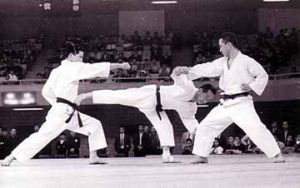 Originally, the martial art Te (“Hand”) developed in Okinawa as a system of self-defense. Due to Okinawa’s frequent contact and exchange with China, it is certain that the Okinawan martial art was influenced by Chinese kempo at some point during its development. However, with only oral tradition and no formal contemporary written records, it is not certain exactly when the art called Kara-Te first emerged in Okinawa. It is believed that it developed roughly 500 years ago, when the dynastic ruler King Shoha unified the region after decades of warfare and issued an edict banning the possession of weapons on the island.
Originally, the martial art Te (“Hand”) developed in Okinawa as a system of self-defense. Due to Okinawa’s frequent contact and exchange with China, it is certain that the Okinawan martial art was influenced by Chinese kempo at some point during its development. However, with only oral tradition and no formal contemporary written records, it is not certain exactly when the art called Kara-Te first emerged in Okinawa. It is believed that it developed roughly 500 years ago, when the dynastic ruler King Shoha unified the region after decades of warfare and issued an edict banning the possession of weapons on the island.
According to conventional accounts, a similar law forbidding the possession or use of weapons was re-issued and enforced by the Satsuma clan, who had invaded Okinawa in the early 1600’s and brought it under the rule of the Japanese Shogunate. It is believed that in this environment karate developed as a form of unarmed combat for protecting oneself and one’s country, and it was taught and practiced in secret.
Then came the birth in 1868 of Okinawan karate master Funakoshi Gichin. He dedicated his whole life to promoting the values of the art, and introduced the way of karate-jutsu to Japan, where it spread across the country. By 1949, his followers had established an association for the promotion of karate; they called it Nihon Karate Kyokai, or Japan Karate Association. It was the beginning of the JKA…
More on the history of the JKA:
The Early Years (1948-1957)
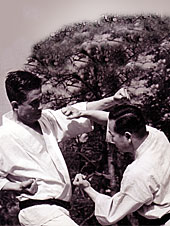 The JKA was founded in November, 1948. By 1955, the first headquarters dojo had been built at Yotsuya in Tokyo, and the first JKA Chairman had been appointed: Saigo Kichinosuke, member of the upper house of the Japanese Diet and grandson of Saigo Takamori, one of the greatest heroes of Meiji Japan. In 1956, the JKA set up the first-ever karate specialist instructor intern (kenshusei) training program at the headquarters dojo, and accepted its first round of trainees. This was the start of the finest karate instructor training program ever created, a program never matched or even approached by any other karate organization. It is through this program that the JKA has built up its unique cadre of distinguished karate instructors, all full-time salaried professionals— whose numbers are consistently maintained at roughly twenty individuals.
The JKA was founded in November, 1948. By 1955, the first headquarters dojo had been built at Yotsuya in Tokyo, and the first JKA Chairman had been appointed: Saigo Kichinosuke, member of the upper house of the Japanese Diet and grandson of Saigo Takamori, one of the greatest heroes of Meiji Japan. In 1956, the JKA set up the first-ever karate specialist instructor intern (kenshusei) training program at the headquarters dojo, and accepted its first round of trainees. This was the start of the finest karate instructor training program ever created, a program never matched or even approached by any other karate organization. It is through this program that the JKA has built up its unique cadre of distinguished karate instructors, all full-time salaried professionals— whose numbers are consistently maintained at roughly twenty individuals.
On April 10, 1957, the JKA became a legal entity when Japan’s Ministry of Education (now Ministry of Education, Science, Sports, and Culture) officially recognized the JKA as an association of members for the promotion of karate and the spread and enrichment of actual karate practice. Twelve years later, another karate organization was also given legal status, based not on membership but on contribution by an individual foundation, mainly for the purpose of arranging karate matches.
Roughly two weeks after official status was granted, Supreme Master Funakoshi passed away at the age of 89. After almost a decade of milestones, it was the end of an era. But the real growth of karate was yet to come.
Growth & Development (1957-1989)
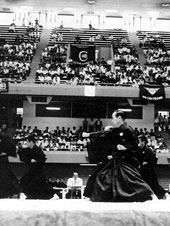 Karate’s popularity continued to grow. In October 1957, the 1st JKA All Japan Karate Championship was held in Tokyo. At this first tournament, the first karate match rules tournament in history, the number of divisions was limited to four: men’s individual (general) kumite and kata, and men’s group (Prefectural) kumite and kata.
Karate’s popularity continued to grow. In October 1957, the 1st JKA All Japan Karate Championship was held in Tokyo. At this first tournament, the first karate match rules tournament in history, the number of divisions was limited to four: men’s individual (general) kumite and kata, and men’s group (Prefectural) kumite and kata.
Once this annual tournament system was established, it wasn’t long before there were JKA karate branches in towns, schools and as many as 40 prominent universities in Japan. In 1958, Master Nakayama was appointed Chief Instructor. In 1961, His Majesty the Crown Prince of Japan (now His Majesty the Emperor of Japan) attended the 5th JKA All Japan Karate Championship. JKA karate was getting noticed.
Over the years, the tournament divisions expanded to include: a university division (1969), a women’s kata division (1974), a youth division within the general division (1975), an entirely separate youth division for elementary, junior high and high school students, and a women’s kumite division (1985). In addition, the number of participants grew enormously.
During this period, the JKA further developed its karate instruction system, and while greatly expanding its branch dojo throughout Japan, began sending (as early as 1958) some of its most highly-accomplished professional instructors overseas to America, Europe and the Middle East to teach and establish dojo. Karate was becoming a big hit outside Japan too.
In 1975, with karate’s prospective entry into the Olympics in mind, the first JKA-sponsored international tournament, the IAKF (International Amateur Karate Federation) World Cup was held in the U.S.; over the following several years it was held three additional times. However, in order to preserve the true technique and spirit of ippon-shobu (downing the opponent with one blow), the JKA ultimately established a new tournament, the Shoto World Cup Karate Championship Tournament. In 1985, the first international Shoto World Cup was held in Japan, a testimony to how much karate had become an international art.
This period witnessed spectacular development in the art of karate.As a result of continuous training among instructors, the karate techniques were developed into a complete system. For the first time there emerged a clear, scientific, and practical “best” form for each kumite stance, posture and movement. There also emerged a clear delineation between the “correct” and “incorrect” way to execute each stance, punch, kick or technique.
Once these techniques developed, many instructors went overseas to spread the art of karate around the world. The JKA was the first karate organization to set up dojo outside Japan. This is the reason the JKA is so prominent and powerful overseas.
Furthermore, the JKA became the only karate organization to send its qualified full-time instructors to teach karate at universities. In contrast, some other universities simply have one of their old students hold karate classes.
In 1986, Nakahara Nobuyuki, a distinguished business leader and former Tokyo University Karate Club member, was appointed the eighth Chairman of the JKA.
Sadly, as JKA karate was reaching a pinnacle, Master Nakayama passed away, in 1987. He was 74 years old.
Overcoming Challenges (1990-1999)
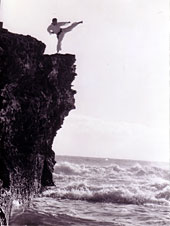 In 1990, the JKA was rocked by crisis when a faction within the organization seized the JKA’s official status. The group called an extraordinary General Assembly meeting, but did not identify the agenda or state the purpose as legally required. After this unlawful meeting, the faction succeeded in illegally changing the official executive register. Thus began a long period of litigation.
In 1990, the JKA was rocked by crisis when a faction within the organization seized the JKA’s official status. The group called an extraordinary General Assembly meeting, but did not identify the agenda or state the purpose as legally required. After this unlawful meeting, the faction succeeded in illegally changing the official executive register. Thus began a long period of litigation.
Despite this, the JKA continued to progress. The overwhelming majority of members and instructors remained loyal to the original and true JKA. Then Master Sugiura Motokuni was appointed to the position of Chief Instructor in 1991. Together with Chairman Nakahara, they began initiating a return to the true spirit of karate—just when that spirit was needed most.
In 1994, the JKA published the first in a series of five authoritative text-books on kata. This series quickly became the “bible” of karate kata.
Then came the court rulings. In 1995, as members had long expected, the JKA won the case in Tokyo Local Court. In 1998, it won again in Tokyo Higher Court. Then in June 1999, the Japan Supreme Court rejected the appeal of the seceded group, and the case was closed once and for all. As a result, the legal executive register was restored to the state it was in before the faction had so forcefully changed it.
In the end, the JKA had not only weathered the challenge, but had grown stronger because of it. It had gained more internal cohesion and a stronger sense of identity than ever before.
The JKA Leaps Forward into the 21st Century (2000 to present)
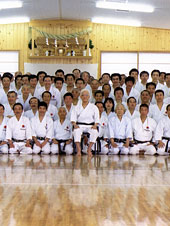 With its legal status restored by court rulings, the JKA leapt into the 21st Century. It restructured its internal organization, and also reorganized its financial base.
With its legal status restored by court rulings, the JKA leapt into the 21st Century. It restructured its internal organization, and also reorganized its financial base.
In December 2000, it purchased land and established a brand new headquarters and dojo in the center of Tokyo. This was the first time the JKA had owned its own land and building. The grand opening ceremony was held in May 2001, attended by numerous dignitaries and many members from other karate organizations.
With renewed vigor, the JKA repositioned itself, clearly defining itself as ‘The Keeper of Karate’s Highest Tradition.’ In 2004, it launched a new official website, through which it continues, as always, to promote true karate around the world.
The Japan Karate Association (JKA) was originally established in 1948 as a not-for-profit organization. Based on its significant contribution to society through a number of activities, the Japanese Ministry of Education recognized JKA as SHADAN HOJIN (incorporated association) in 1957. Through continuous contribution and its commitment to society, JKA was further recognized by the government of Japan as KOEKI SHADAN HOJIN (public interest incorporated association) on March 21, 2012. JKA is the only Japanese martial arts associations to date to be given such recognition by its government.
The mandate of JKA is to contribute to world peace through 1) conducting research and providing instruction of Karate-Do, 2) influencing children and adolescents to improve their physical and mental health as well as cultivating the spirit of martial arts, and 3) wide distribution of the concept of Japanese martial art which emphasizes manners and respect.
JKA members endeavor to develop their characters and contribute to society on a daily basis, this is the objective of JKA and is the truth value of Karate-Do as a martial art. JKA takes this responsibility seriously and always endeavor to contribute to society through various activities.
History of the Japan Karate Association
Since then, a yearly celebration of All Japan Karate Championship was conducted.
The cabinet office certified Japan Karate Association as a Public Interest Incorporated Association (government benefit no. 2749).
Organizational Structure
The Japan Karate Association is the only independent karate entity legally and officially recognized by the Japanese government as an association of members (Shadan Hojin) for the promotion of karate. There is only one other authorized entity which falls under the umbrella of the JKA: the JKA World Federation (JKA/WF). No other organization shares this status. Likewise, the JKA is not dependent upon or subordinate to any other group, organization or entity. However, there are instances in which the JKA cooperates of its own volition with other organizations in an equal stance.
For the most part, the JKA is centrally organized and coordinated through Tokyo JKA HQ, although there are both National and Regional headquarters in most areas around the world.
The basic structure of the JKA’s executive committee is shown below.
Philosophy
The Way of Balance
Forging a Karate Mind
True karate is based on Bushido. In true karate, the body, mind and spirit—the whole person—must be developed simultaneously. Through kihon, kumite and kata we learn to control our movements. But more importantly, we learn to give up control too. We can perform the techniques without thinking about them, and remain focused without having to concentrate on any one thing. In essence, the body remembers how to move and the mind remembers how to be still.
Bushido: The Way of the Samurai
The Twenty Precepts of Karate
The Dojo Kun
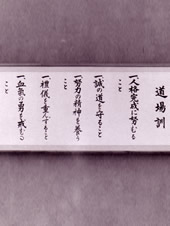
Senior instructors at the JKA developed the Dojo Kun, which everyone studying at the JKA commits to memory. With each practice session at the dojo, students kneel in the seiza position and repeat these five precepts out loud. This process reminds students of the right attitude, frame of mind and virtues to strive for both within the dojo, and outside.
.jpg)
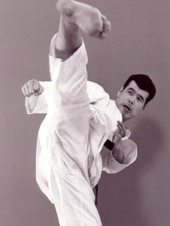 At the JKA, we put immense focus on the proper form and balance of each kihon, or basic technique. Through extensive training, our instructors have rigorously, scientifically analyzed and separated out each individual movement in each individual kata, and developed an unrivalled spectrum of kihon techniques. Using these special kihon, we have refined the kata to be more applicable in kumite. And in turn, the experience accumulated through kumite gives feedback to further perfect one’s kihon and kata. In this way kihon, kata and kumite form the inseparable trinity of JKA karate. Through constant repetition of such techniques, your body learns to move effortlessly, naturally. And your mind learns to be effortless and natural too. JKA karate is the way of balance.
At the JKA, we put immense focus on the proper form and balance of each kihon, or basic technique. Through extensive training, our instructors have rigorously, scientifically analyzed and separated out each individual movement in each individual kata, and developed an unrivalled spectrum of kihon techniques. Using these special kihon, we have refined the kata to be more applicable in kumite. And in turn, the experience accumulated through kumite gives feedback to further perfect one’s kihon and kata. In this way kihon, kata and kumite form the inseparable trinity of JKA karate. Through constant repetition of such techniques, your body learns to move effortlessly, naturally. And your mind learns to be effortless and natural too. JKA karate is the way of balance.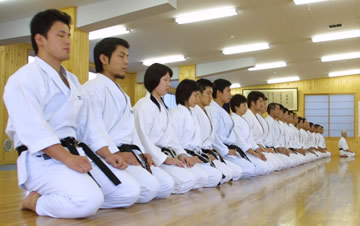 Karate is not a game of points, weight classes or showy demonstrations. It is a martial art and way of life that trains a practitioner to be peaceful; but if conflict is unavoidable, true karate dictates taking down an opponent with a single blow.
Karate is not a game of points, weight classes or showy demonstrations. It is a martial art and way of life that trains a practitioner to be peaceful; but if conflict is unavoidable, true karate dictates taking down an opponent with a single blow.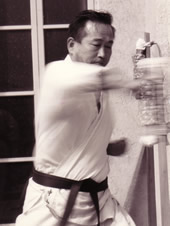 Bushido has been the samurai code of conduct in Japan for centuries. Based firmly on the teachings of Zen, Bushido was intended to help the samurai master their nature and understand their minds and the universe through direct experience—as well as through fostering strength, self-control and wisdom.
Bushido has been the samurai code of conduct in Japan for centuries. Based firmly on the teachings of Zen, Bushido was intended to help the samurai master their nature and understand their minds and the universe through direct experience—as well as through fostering strength, self-control and wisdom.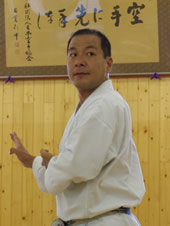 Before he established the JKA, Master Funakoshi Gichin laid out the Twenty Precepts of Karate, which form the foundations of the art. Within these twenty principles, based heavily on Bushido and Zen, lies the philosophy of the JKA.
Before he established the JKA, Master Funakoshi Gichin laid out the Twenty Precepts of Karate, which form the foundations of the art. Within these twenty principles, based heavily on Bushido and Zen, lies the philosophy of the JKA.





Amazing blog. Thanks for sharing this with us.
ReplyDeleteAikido Classes NYC